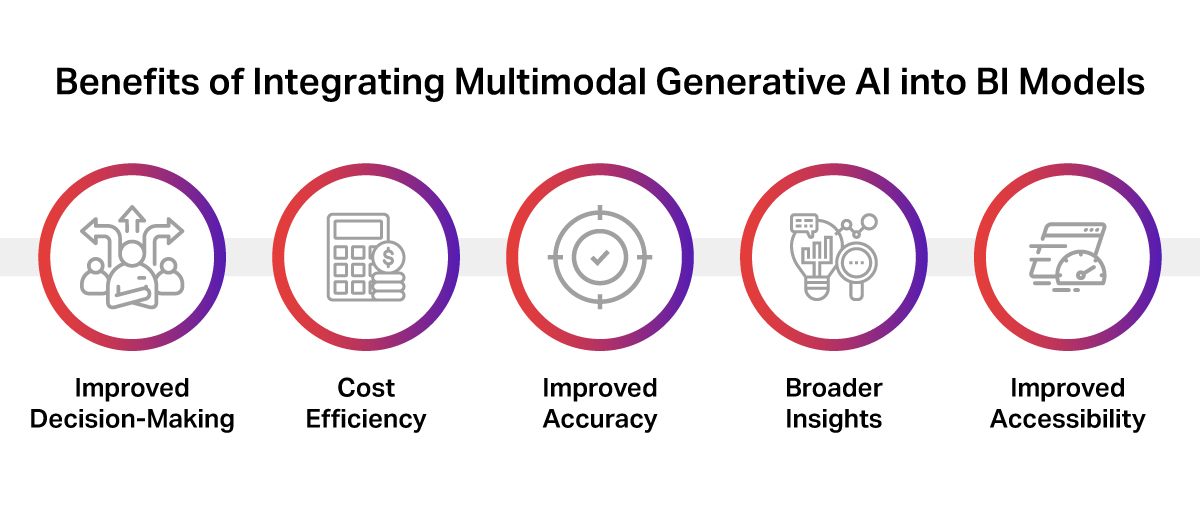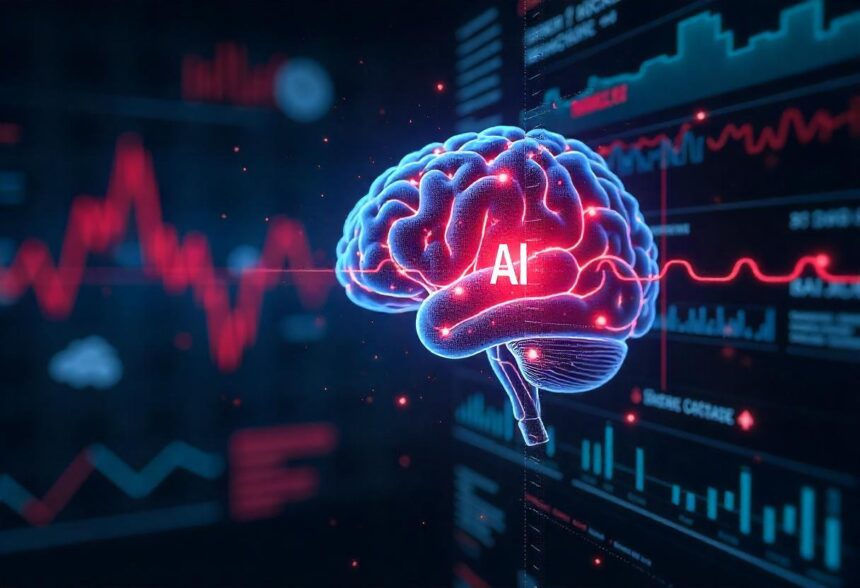Business Intelligence (BI) enables businesses to make informed decisions by transforming raw data into actionable insights. The raw data can originate from various sources, including sales data, customer information, website analytics, operational data, marketing data, industry trends, and more.
The global business intelligence market size was valued at USD 29.42 billion in 2023 and is expected to grow from $31.98 billion in 2024 to $63.76 billion by 2032.
As the volume and complexity of data continue to grow, businesses are turning to advanced technologies like artificial intelligence (AI) to extract meaningful information.
Multimodal generative AI is transforming how BI models work. It can process different data types, such as text, images, and audio, offering a better and more accurate understanding of business operations by combining data from different modalities. This capability makes it a crucial technology for the next generation of BI models.
Let’s discuss how this combination of multimodal generative AI and BI models marks the next step in data analysis.
Understanding Multimodal Generative AI
Multimodal Generative AI is a powerful form of artificial intelligence capable of processing and generating data across formats like text, images, audio, and even structured data such as numbers or charts. By integrating diverse data types, it offers a more complete understanding, making it a transformative tool for businesses. Notably, studies suggest that generative AI could contribute up to $4.4 trillion to the global economy each year.
Unlike traditional AI, which typically focuses on a single type of data, multimodal AI leverages cross-modal embeddings to learn associations between different data types. This multi-faceted approach enables more meaningful outcomes for complex business tasks.
The technology behind multimodal generative AI includes Transformers and Large Language Models (LLMs). Transformers process complex data relationships, while LLMs provide contextual understanding, enhancing the reliability and effectiveness of AI in business intelligence applications.
Evolution of BI Models with Multimodal AI
The evolution of business intelligence (BI) models is changing how businesses analyze their data. Traditional BI models primarily relied on structured data, such as reports and spreadsheets. While this approach was helpful, it was limited to predefined formats as it overlooked important information hidden in unstructured data, like emails and social media posts.
The integration of artificial intelligence into BI enabled the analysis of unstructured data. It broadened the scope of information businesses could use. This allowed businesses to tap into more sources of information for their analysis.
However, the real game-changer is the shift to multimodal AI. Multimodal AI could integrate different data types, including text, images, and video, in one analysis. This approach generates rich and more detailed insights for businesses, helping them capture the full scope of their operations and make informed decisions. The ability to combine different data modes is pushing BI to new levels of accuracy and efficiency.
Multimodal Generative AI’s Impact on BI Models
Multimodal generative AI is impacting BI models by taking data integration and analysis to a whole different level. Here is how:
- Enhanced Data Integration : This technology helps businesses combine structured data, such as numerical reports, with unstructured data, visual analytics, and audio recordings. This strategy can offer a better understanding of business performance.
- Cross-Modal Analysis : Multimodal AI can link different data types to generate insights. For example, AI can combine image recognition with text analytics to identify patterns that would have been missed using traditional methods.
- Advanced Reporting : Multimodal AI can also facilitate advanced reporting. It can create reports with numbers, text, visualizations, and audio summaries. These enhanced reports are more engaging and informative.
- Personalized Insights : Multimodal data can be used to tailor BI outcomes to address specific business questions. For example, a company can use multimodal AI to analyze customer feedback data and identify areas for improvement.
Benefits of Integrating Multimodal Generative AI into BI Models
Integrating multimodal generative AI into BI models offers multiple benefits, such as:
- Improved Decision-Making: With real-time insights from various data types, businesses can make faster and more informed decisions. This is especially useful in industries where quick responses are important.
- Cost Efficiency : Multimodal AI saves time and labor costs by reducing the need for manual data processing. This automated analysis helps companies focus on strategic actions rather than tedious data management.

- Improved Accuracy: Cross-modal analysis helps reduce data silos and ensures that businesses are using all available data to make decisions. This can lead to more accurate insights and better outcomes.
- Broader Insights: Businesses gain broader insights by using diverse data types. This gives a more complete view of operations and customer behaviors.
- Improved Accessibility : Multimodal outputs like voice-activated reports can make BI insights more accessible to non-technical stakeholders. This helps ensure everyone in a company is up to speed on business goals and strategies.
Challenges in Implementing Multimodal Generative AI in BI
While multimodal generative AI offers significant benefits, there are also several challenges to consider when implementing it in BI models:
- Data Complexity: Companies need to manage and integrate diverse data formats from various sources. This process can be difficult and time-consuming. Without proper management, companies can encounter data silos that will result in fragmented insights and hinder the efficiency of AI-driven analytics.
- Infrastructure Requirements: Multimodal AI models often require advanced computational power to process large amounts of data and generate accurate results. This technology can be costly for businesses to maintain.
- Interpretability of Models: Ensuring that multi-modal AI outputs are easy to understand for business users can be a challenge. These models can be complex and difficult for non-technical users to interpret.
- Ethical and Privacy Considerations: Safeguarding sensitive multimodal data, such as voice and video feeds, is also a significant challenge for businesses. Failing to protect this data can lead to breaches of trust with customers and stakeholders and potential legal repercussions.
Applications of Multimodal Generative AI in BI Models
Multimodal Generative AI has many applications in BI models. It is changing the way companies analyze their data and make decisions. Here are some key applications:
- Anomaly Detection and Fraud Prevention
Multimodal AI can analyze data from multiple sources to identify unusual patterns or behaviors. It can examine business data such as transaction records and social media activity to detect anomalies that may indicate fraud. For example, it can detect discrepancies between customer purchase data and shipping information. This can help businesses avoid issues like financial losses, reputational damage, and legal issues. - Scenario Planning and Simulation
Multimodal AI can create and simulate different scenarios by combining historical data with predictive models. This can help businesses understand the potential impact of their decisions and strategies. For example, a company can use multimodal AI to simulate the effect of a new marketing campaign on sales and customer satisfaction. It can also help them to anticipate potential challenges and adjust their strategies accordingly to maximize sales and enhance customer satisfaction. - Customizable Insights
Multimodal AI can be used to create highly customized insights tailored to the specific needs of individual users. Organizations can gain a comprehensive view of their performance by integrating different data types, such as customer feedback and sales data. For example, a sales manager can use multimodal AI to create a report showing different sales teams’ performance. The report can also be broken down by product category and region. - Automated Report Generation
Multimodal AI streamlines the report generation process. It can automatically compile data from various sources and create detailed reports. For example, multimodal AI can generate daily sales reports, including text, charts, and audio explanations. This saves time and reduces the risk of human error. - Predictive Analytics and Forecasting
As multimodal AI can analyze diverse data types, it helps businesses generate more accurate forecasts about future trends and behaviors. This information is invaluable for planning and resource allocation. For example, a retailer can use multimodal AI to predict product demand based on historical sales data and weather forecasts. - Data Preparation and Optimization
Multimodal AI can automate data preparation tasks, such as data cleaning, normalization, and feature engineering. This way, businesses can streamline their operations based on real-time data insights. It can also make sure the information used in BI models is accurate and reliable by organizing data. This leads to better insights and informed decision-making.
How to implement AI in BI
It is important to follow a structured approach to successfully implement multimodal AI in BI. Here is how you can implement AI in BI efficiently:
- Specify Business Objective : The first step is to identify what you want to achieve by using AI in BI models. This could be anything from improving the accuracy of sales forecasts to identifying new customer segments.
- Prepare Your Data : The next step is to prepare your data for use with AI models. As AI relies on both structured and unstructured data, clean and organize your datasets to ensure their accuracy and reliability.
- Select the Right Tool : Choose an AI platform that fits your business needs. Look for a platform that supports multimodal AI, enabling the integration of diverse data types for deeper analysis.
One excellent solution is iMerit’s Ango Hub. It’s a robust platform designed to streamline data annotation workflows across various data types, such as images and video. By providing efficient annotation tools, Ango Hub can enhance the data quality needed for training AI models, ultimately boosting the capabilities of your AI systems.
Future Trends in Multimodal Generative AI and Business Intelligence
The future of multimodal generative AI in business intelligence is set to bring exciting advancements. These include:
- There is an increasing reliance on AI-powered BI tools for handling multimodal data. This will allow businesses to process text, images, and audio for deeper insights.
- The convergence of Generative AI, IoT, and edge computing is also growing. This combination will enhance real-time data processing so businesses can make faster and more accurate decisions based on live data from connected devices.
- The emergence of cross-modal interfaces will change how users interact with BI systems. These interfaces will help stakeholders to engage with data using voice commands and visual elements.
Take the Next Step: Explore iMerit’s Ango Hub Today!
Multimodal generative AI is transforming business intelligence by enhancing data integration and providing richer insights. Its ability to process and analyze diverse data types leads to more comprehensive BI models that can address complex business challenges.
As businesses face growing amounts of diverse data, using advanced AI solutions becomes essential for staying competitive. iMerit’s Ango Hub is designed to meet this need by offering a powerful platform for multimodal AI processing. Whether you’re dealing with text, images, video, or audio, Ango Hub seamlessly integrates these different data types into your BI systems for deeper insights.
Ready to take your BI models to the next level? Explore how iMerit’s Ango Hub can help you unlock your business’s full potential through multimodal AI.
Contact us today to learn more!


























